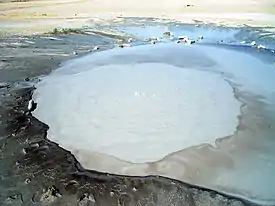Hingol mud volcanoes
The Hingol mud volcanoes (Urdu: ہنگول مٹی کے آتش فشاں) are located in Lasbela District, Balochistan, Pakistan at a distance of around 100 km from Uthal, which is the headquarter of District Lasbela. The mud volcanoes are located in Hingol National Park which is the largest national park in Pakistan.[1] It contains about ten clusters of mud volcanoes, the most important of which are Chandragup and Khandewari volcanoes.[2]

These are not located on the main road about a kilometer off the Makran Coastal Highway leading from Lasbela to Gwadar; the locals may provide guidance to the exact location. A landmark is a SSGC installation. The site is a complex of three major mud volcanoes and a number of smaller ones.
The three mud volcanoes of the location are named as Chandragup1, Chandragup2 and Chandragup3.[3] One of which is a 300-foot-high mud volcano. It is a sacred annual pilgrimage site for Hindus, along with the closeby Hinglaj Mata mandir.[1][4][5] Also known as Chandrakup, the volcano is considered holy by Hindus and is an important stop for pilgrims on their way to the Hinglaj Mata temple.[6] Devotees throw coconuts into the craters to make wishes and thank the gods for answering their prayers.[7]
 Mud Volcano 1
Mud Volcano 1 Mud Volcano 2
Mud Volcano 2 Mud Volcano 3
Mud Volcano 3
See also
References
- "Pakistan's Most Wild and Beautiful Places". National Geographic. Retrieved 22 August 2018.
- "Hingol Cultural Landscape". UNESCO World Heritage Centre.
- V. Santiago-Fandino, H. Tanaka, M. Spiske. Tsunamis and Earthquakes in Coastal Environments: Significance and Restoration. Springer. ISBN 9783319285283.CS1 maint: multiple names: authors list (link)
- Xafar, Ali (20 April 2016). "Mata Hinglaj Yatra: To Hingol, a pilgrimage to reincarnation". Express Tribune.
- Mulki, Muhammad Adil (24 February 2013). "Footprints in the mud". Express Tribune.
- Mud Volcanoes of Balochistan Archived 2012-09-15 at the Wayback Machine, Owais Mughal, 2 March 2007, All Things Pakistan, Accessed: 25 September 2012, ... Very close to Chandargup is an ancient Hindu temple called ‘Hinglaj temple’ or ‘Nani Temple’. There are many pronunciations of the word Chandragup in practise. Due to close proximity a Hindu temple to these volcanoes, it is very likely that the word Chandargup is actually derived from the word ‘Chandargupt’. Another word which locally mentions this group of volcanoes is ‘Chandra coop’ which means Volcanoes of the Moon ... The Hindus worship these mud volcanoes as the habitation of a deity Babhaknath ...
- https://www.nationalgeographic.com/culture/2019/01/muslim-majority-country-hindu-goddess-lives-pakistan-pictures/#/18_hindu_pilgrimage_mmi8851_180405_2272.jpg